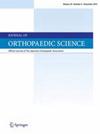基于负重计算机断层扫描和三维分析的HALUX僵直、HALUX外翻和正常足的第一缕活动度:病例对照研究
IF 1.4
4区 医学
Q3 ORTHOPEDICS
引用次数: 0
摘要
拇外翻和拇僵硬是影响第一道光线的疾病,并与该结构的过度活动有关。本研究旨在通过负重和非负重计算机断层扫描(CT)研究拇外翻或拇刚性足与健康足之间的第一线关节的三维活动性。方法对11例健康志愿者17尺(对照组)、16尺(HV组)、16尺(HR组)的11例拇硬直患者进行病例对照研究。首先,在无负荷的加载装置上仰卧位进行非负重足部CT成像,腿部伸展,踝关节处于中立位。接下来,施加相当于体重的负荷进行负重CT成像。在两种情况下,对远端骨相对于近端骨的位移进行三维量化。结果HV组距舟关节外翻(P = 00.011)明显大于对照组,背屈(P = 00.027)和外翻(P <;00.01),与HR组比较。内侧楔状关节,HV组外翻明显增大(P <;00.01)和外展(P = 00.011)明显高于对照组。对于第一跗跖关节,HV组表现出更大的背屈(P = 00.014)、内翻(P = 00.028)和内收(P <;00.01),且反转更大(P <;00.01)和内收(P <;00.01)高于HR组。HR组第一跗跖关节背屈度明显高于对照组(P = 00.026)。结论第一线超活动表现为三维:拇外翻以跗跖第一关节为中心,拇僵直主要以跗跖第一关节矢状面为中心。这种差异可以解释在每种情况下最终观察到的不同畸形。本文章由计算机程序翻译,如有差异,请以英文原文为准。
First ray mobility in hallux rigidus, hallux valgus, and normal feet based on weightbearing computed tomography and three-dimensional analysis: A case-control study
Background
Hallux valgus and hallux rigidus are disorders affecting the first ray and are associated with hypermobility of this structure. This study aimed to investigate the three-dimensional mobility of each joint of the first ray between feet with hallux valgus or hallux rigidus and healthy feet using weightbearing and nonweightbearing computed tomography (CT).
Methods
This case-control study analyzed 17 feet of 11 healthy volunteers (control group), 16 feet of 16 patients with hallux valgus (HV group), and 16 feet of 11 patients with hallux rigidus (HR group). First, nonweightbearing foot CT imaging was performed in the supine position on a loading device with no load applied, with the legs extended and the ankle in the neutral position. Next, a load equivalent to body weight was applied for weightbearing CT imaging. Distal bone displacement relative to the proximal bone was quantified three-dimensionally under both conditions.
Results
In the HV group, the talonavicular joint showed significantly greater eversion (P = 00.011) compared with the control group and significantly greater dorsiflexion (P = 00.027) and eversion (P < 00.01) compared with the HR group. In the medial cuneiform joint, the HV group showed significantly greater eversion (P < 00.01) and abduction (P = 00.011) than the control group. For the first tarsometatarsal joint, the HV group showed significantly greater dorsiflexion (P = 00.014), inversion (P = 00.028), and adduction (P < 00.01) than the control group, and greater inversion (P < 00.01) and adduction (P < 00.01) than the HR group. Dorsiflexion of the first tarsometatarsal joint was significantly greater in the HR group compared with the control group (P = 00.026).
Conclusion
Hypermobility of the first ray appears to be three-dimensional: in hallux valgus, it is centered at the first tarsometatarsal joint, while in hallux rigidus it is mainly in the sagittal plane at the first tarsometatarsal joint only. This difference may explain the different deformities ultimately observed in each condition.
求助全文
通过发布文献求助,成功后即可免费获取论文全文。
去求助
来源期刊

Journal of Orthopaedic Science
医学-整形外科
CiteScore
3.00
自引率
0.00%
发文量
290
审稿时长
90 days
期刊介绍:
The Journal of Orthopaedic Science is the official peer-reviewed journal of the Japanese Orthopaedic Association. The journal publishes the latest researches and topical debates in all fields of clinical and experimental orthopaedics, including musculoskeletal medicine, sports medicine, locomotive syndrome, trauma, paediatrics, oncology and biomaterials, as well as basic researches.
 求助内容:
求助内容: 应助结果提醒方式:
应助结果提醒方式:


